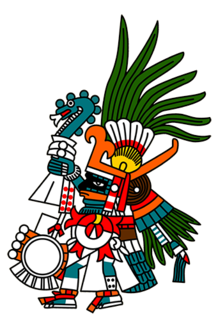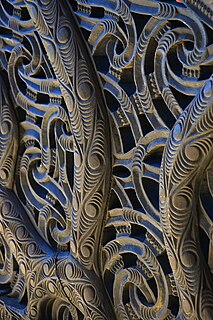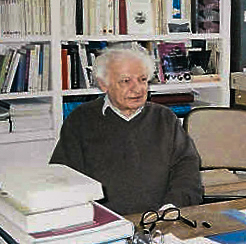
In the Aztec religion, Huitzilopochtli is a deity of war, sun, human sacrifice, and the patron of the city of Tenochtitlan. He was also the national god of the Mexicas, also known as Aztecs, of Tenochtitlan. Many in the pantheon of deities of the Aztecs were inclined to have a fondness for a particular aspect of warfare. However, Huitzilopochtli was known as the primary god of war in ancient Mexico. Since he was the patron god of the Mexica, he was credited with both the victories and defeats that the Mexica people had on the battlefield. The people had to make sacrifices to him to protect the Aztec from infinite night. He wielded Xiuhcoatl as a weapon, associating him with fire.
The Guaraní people live in south-central part of South America, especially in Paraguay and parts of the surrounding areas of Argentina, Brazil, and Bolivia.

In Māori mythology, Tāwhaki is a semi-supernatural being associated with lightning and thunder.

Hindu mythology are narratives found in Hindu texts such as the Vedic literature, epics like Mahabharata and Ramayana, the Puranas, the regional literatures like Periya Puranam. Hindu mythology is also found in widely translated popular texts such as the Panchatantra and Hitopadesha, as well as Southeast Asian texts.

Matsya is the fish avatar in the ten primary avatars of Hindu god Vishnu. Matsya is described to have rescued Manu and earthly existence from a great deluge.
In Norse mythology, Angrboða or Angrboda is a female jötunn. In the Poetic Edda, Angrboða is mentioned only in Völuspá hin skamma as the mother of Fenrir by Loki. However, in the Prose Edda book Gylfaginning, she is referred to as a "Jotunn in Jötunheimr" and said also to be the mother of Fenrir's siblings Jörmungandr and Hel. She may be the same as Iárnvidia, 'She of Iron-wood', mentioned in the list of troll-wives in the Prose Edda list nafnaþulur.

In Mexican folklore, La Llorona is the ghost of a woman who drowned her children and now cries while looking for them in the river, often causing misfortune to those who are near or hear her. There is no credible source or evidence to the events that inspired the tale/legend of La Llorona.

Kamadhenu, also known as Surabhi, is a divine bovine-goddess described in Hinduism as the mother of all cows. She is a miraculous "cow of plenty" who provides her owner whatever he desires and is often portrayed as the mother of other cattle. In iconography, she is generally depicted as a white cow with a female head and breasts, the wings of a bird, and the tail of a peafowl or as a white cow containing various deities within her body. All cows are venerated in Hinduism as the earthly embodiment of the Kamadhenu. As such, Kamadhenu is not worshipped independently as a goddess, and temples are not dedicated to her honor alone; rather, she is honored by the veneration of cows in general throughout the observant Hindu population.
The crone is a character in folklore and fairy tale, an old woman. In some stories, she is disagreeable, malicious, or sinister in manner, often with magical or supernatural associations that can make her either helpful or obstructing. The Crone is also an archetypal figure, a Wise Woman. As a character type, the crone shares characteristics with the hag.
Princess is a regal rank and the feminine equivalent of prince. Most often, the term has been used for the prince consort of a prince or for the daughters of a king or sovereign prince.

Yves Jean Bonnefoy was a French poet and art historian. He also published a number of translations, most notably the plays of William Shakespeare which are considered among the best in French. He was professor at the Collège de France from 1981 to 1993 and is the author of several works on art, art history, and artists including Miró and Giacometti, and a monograph on Paris-based Iranian artist Farhad Ostovani. The Encyclopædia Britannica states that Bonnefoy was ″perhaps the most important French poet of the latter half of the 20th century.″
Snow-White-Fire-Red is an Italian fairy tale collected by Thomas Frederick Crane in Italian Popular Tales.
In the Melanesian mythology of Malekula Island, Vanuatu, Ambat is a culture hero recorded by A.B. Deacon. In the myth, Temes Malau has an ogress wife Nevinbumbaau and had a son Mansip. Nevinbumbaau trapped Ambat's older brothers one after another in a ditch, where they stayed until Ambat came to free them. The same brothers later tried to kill Ambat because they envied him his beautiful wife Lindanda, who learned of her husband's death when she saw blood on the comb he had left her. She escaped from the brothers, who thought they had won.

Dzunuḵ̓wa, also Tsonoqua, Tsonokwa, Basket Ogress, is a figure in Kwakwaka'wakw mythology and Nuu-chah-nulth mythology.
The Three Crowns is an Italian literary fairy tale written by Giambattista Basile in his 1634 work, the Pentamerone.

Jewish mythology is a major literary element of the body of folklore found in the sacred texts and in traditional narratives that help explain and symbolize Jewish culture and Judaism. Elements of Jewish mythology have had a profound influence on Christian mythology and on Islamic mythology, as well as on world culture in general. Christian mythology directly inherited many of the narratives from the Jewish people, sharing in common the narratives from the Old Testament. Islamic mythology also shares many of the same stories; for instance, a creation-account spaced out over six periods, the legend of Abraham, the stories of Moses and the Israelites, and many more.
Malagasy mythology is rooted in oral history and has been transmitted by storytelling, notably the Andriambahoaka epic, including the Ibonia cycle.
Buga is a creator god and omnipotent highest power in the mythology of the Tungusic peoples.

A Hogon is a spiritual leader in a Dogon village.

This article describes the role of women in the society of the Muisca. The Muisca are the original inhabitants of the Altiplano Cundiboyacense before the Spanish conquest of the Muisca in the first half of the 16th century. Their society was one of the four great civilizations of the Americas.












